Winter is coming! For some folks, perhaps it is already here. If you’re living in a place where wood heat is a primary or supplemental heat source for the winter months, firewood is a big deal.
The Best Kind of Wood to Burn
The best kind of wood to burn will depend on where you live and which kinds of trees are available. Generally speaking, hard woods, like oak and cherry, burn longer and put off more heat, and softer woods, like alder, will burn faster. If you’re burning soft woods, you will need more wood. If you’re burning hard woods, you will get more “bang for your buck,” but you will want to be sure to have a lot of kindling on hand because hard woods can take longer to ignite and get burning. Hard woods can also take longer to dry and season and are notoriously more difficult to split. If you have access to a wood splitter, this shouldn’t be an issue, but if you are splitting your wood by hand, you will want to be sure to have some wedges and a sledgehammer if you are processing a lot of hard woods and larger rounds.
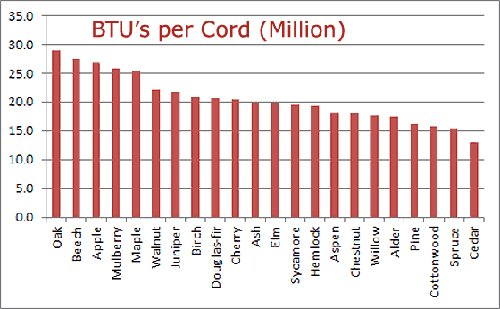
In many climates, you will end up with a mix of hard and soft woods, which can be ideal. You can get the fire going by burning softer wood and then put on a log of hard wood to maintain the blaze. If you are using a mix, you can incorporate this into your stacking strategy so that when you bring wood from your stack to your stove or fireplace you will have a variety of wood in each load to make the process of getting the fire going and keeping it hot much easier. If fire is your only heat source in the colder months, getting a fire going quickly and efficiently can make your living space much more comfortable.
How to Test if Your Wood is “Good”
Regardless of what kinds of wood you plan to burn, it is crucial that the wood is properly seasoned. The amount of time it takes a piece of wood to dry depends on several factors, including the type of wood, the climate (colder, moister climates mean longer drying time), how large the log is, and whether the tree was alive or dead when it was cut.
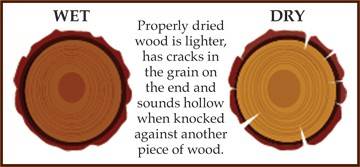
Two good ways to test whether a log is dry are by the weight and by the sound it makes when it hits another piece of wood. Dry wood will be lighter and make a hollow springy sound, whereas wet wood will simply thud. If you’re buying wood from someone else, it is not always easy to tell how dry the wood is just by looking. The sound test can help confirm that the wood is, in fact, dry and ready to burn.
Ideally, wood should be dry and well-seasoned before you stack and store it. For those who plan to harvest their own wood, it is a good idea to plan your wood situation well in advance. You will want to cut and buck up your rounds as early in the year as possible and give the wood time to season during the summer before you split and store the wood.
Tips and Tricks To Store Wood The Right Way
When it comes to storing firewood, there are a lot of tips and tricks that can make the process go smoothly and ensure that you’re getting the most out of your wood. The two most important factors to consider, however, are safety and airflow.
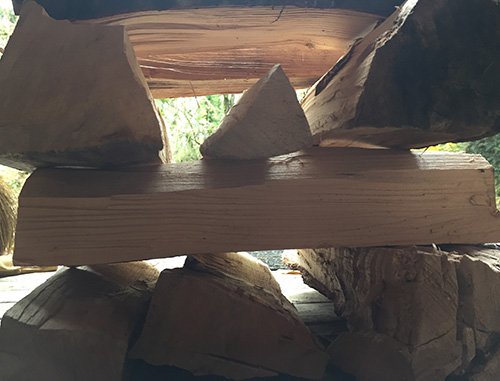 When you’re stacking your wood for storage, you will want to make sure the woodpile is stable and accessible. A haphazard stacking job can lead to a precarious wood pile that comes crashing down, possibly on top of you, which nobody wants. Failure to maintain proper airflow can also lead to moisture accumulating within your stack, which can result in wet, moldy wood waiting for you in the middle of your wood stack: not a pleasant discovery in the middle of December!
When you’re stacking your wood for storage, you will want to make sure the woodpile is stable and accessible. A haphazard stacking job can lead to a precarious wood pile that comes crashing down, possibly on top of you, which nobody wants. Failure to maintain proper airflow can also lead to moisture accumulating within your stack, which can result in wet, moldy wood waiting for you in the middle of your wood stack: not a pleasant discovery in the middle of December!
Related: Trees That Can Be Tapped For Sap And Syrup
There are a lot of techniques for wood stacking, and the best one for you depends on your environment and situation. Storing your wood in a shed or covered area is ideal, particularly in places with moister climates. Generally speaking, simply throwing a tarp over your woodpile is not the best approach to storing wood that you plan to burn during the current season, particularly in wetter and windier environments. Tarps can blow away, rip, and leak. If tarps are all you have, you can set up a makeshift shed with tarps fairly easily. Consider setting up some corner posts around your woodpile and suspending one tarp securely above the pile at a slight angle to direct rainfall away from the wood and using the remaining tarps to protect the sides of the pile. Use some pallets or 2×4’s to keep the bottom layer of wood off the ground to prevent water absorption and keep some ventilation beneath the stack.
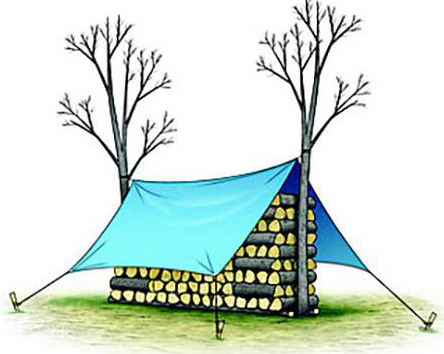 If you’re creating a freestanding woodpile that is not braced on any side, creating a stable wood stack is particularly important. One of the most popular, tried-and-true methods for stacking wood is the “log-cabin” technique. Basically, this means alternating between vertical and horizontal pieces on a row-by-row basis. The alternating pattern will leave space between the logs to allow for air to pass through, preventing moisture buildup, and also provide a stable foundation for the stack. As you use the wood, you will want to work your way down from the top, row by row.
If you’re creating a freestanding woodpile that is not braced on any side, creating a stable wood stack is particularly important. One of the most popular, tried-and-true methods for stacking wood is the “log-cabin” technique. Basically, this means alternating between vertical and horizontal pieces on a row-by-row basis. The alternating pattern will leave space between the logs to allow for air to pass through, preventing moisture buildup, and also provide a stable foundation for the stack. As you use the wood, you will want to work your way down from the top, row by row.
If you’re stacking your wood between walls in a dry, covered area, such as in a shed, you may find that a tighter stacking technique will maximize the amount of wood that you can fit in the space while still allowing for adequate airflow. In this case, you may want to stack your wood so that it is all facing the same direction, rather than alternating. Because the stack will be supported on three sides, your main stability concern in this situation will be the pile toppling forward, towards you. This can be avoided by making sure the pile is not top-heavy. Be sure to arrange the stack evenly, avoiding pile-ups on either side or in the center of the stack. Always pull logs from the top of the stack and work your way down, rather than attempting to pull wood out from the middle.
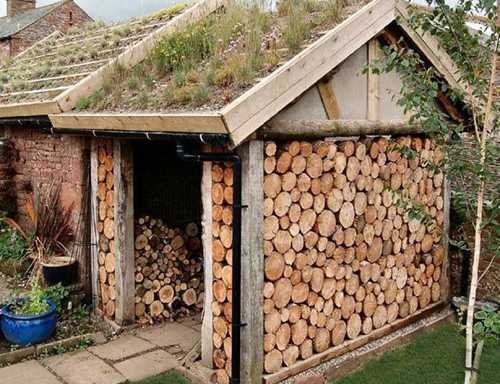 It is a good rule of thumb not to stack wood in piles that are taller than you are. Reaching up to pull wood down from over your head is not recommended, as pieces can dislodge and fall.
It is a good rule of thumb not to stack wood in piles that are taller than you are. Reaching up to pull wood down from over your head is not recommended, as pieces can dislodge and fall.
There is a certain artistry to fitting the pieces together, but it is also not rocket science. For many people relying on wood heat, the journey from the wood stack to the fireplace is a daily one, and creating a stable stack with proper airflow is something that will make this trek much more pleasant.
You may also like:
12 Woodworking Projects for Preppers and Homesteaders
An Insanely Effective Way to Build a 5 Year Food Stockpile (Video)
31 Cool DIY Projects for Preppers
How to Make Firebricks (fire logs) and Wood Stove Logs for Free!
30 Survival Uses for Wood Ashes You Never Thought of

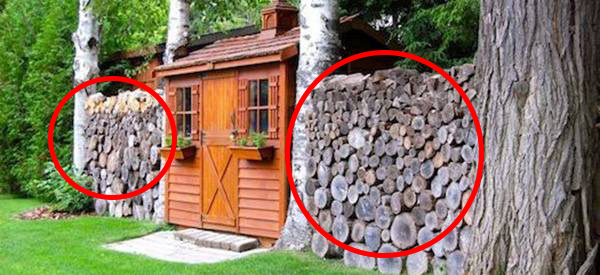











Your list of firewood with their heat values left out mesquite, a hard wood that I use.
When stacking wood in rows, every couple of feet put in a longer piece that will tie the front row to the row behind it to help stabilize it.
I live in Southern Arizona, so the only wood here id Mesquite, whether I cut my own down or purchase a cord, it is always Mesquite. I have 48 on my property. Just did a major trim on my trees, and got a good supply of wood from that, yes, it is green, but here, with little humidity, not much rain,, it will dry fast. Would love to have some oak, but that is not in my financial realm
American ironwood or locust is the hottest fire you can have. I have had it get so hot in my heater you could see the flames through the metal. You left the best one out.
Like superman x-ray vision?
This is getting OLD…this site is nothing but a damn book selling scam…..
Arnie: I must have missed the ad for the book. I didn’t see it on this site. This is the first time I have read this particular article, so it is new to me. You know, if you don’t find this site helpful, just hit the delete key when it shows up in your mailbox. Sure, Claude has ads. Nothing in life is free. Somebody has to pay for Claude taking the time to do this. There are costs involved to him for running the site. You have to pay somehow to get the info that is contained. You pay by Claude having ads on the site, just like on TV. And, just like on TV, if you aren’t interested in the product you go get yourself something to eat or skim past the ad. No sense getting all torqued out about real life. If you don’t find the site helpful, don’t visit it. That’s what the delete key is all about.
Personally, I find this site one of the more helpful preparedness sites that I subscribe to. It sells fewer products and contains more helpful information than any other that come to mind immediately.
This particular post about drying firewood is a lot of common sense, but as someone else remarked somewhere common sense is so uncommon these days as to almost be a super power.
As a beginning prepper I like the info. It has helped me a lot, a few advertisements helps pay for it to keep running. You experienced guys have forgotten what its like to be new. So if some of bores you still positive, its helping us ‘newbies’… be supportive for Gods sake!
This website is far less commercial than all the magpies, tacpen ans fire-starter du jour sites. Best of all it has a breadth of information wide enough to inform everyone from newbies to savvy preppers. I enjoy and learn much from the comments of the other readers as well, especially about soldiers coping during WW2.
Good article Giurgi. I’ve been burning and stacking firewood for 37 years and I always scratched my head at so many people buying tree length firewood in the fall for the upcoming season. They then had to buck and stack it from there.
From the beginning I jumped 2 years ahead so that any wood I was gathering in the current year was for the following heating season. That’s always worked well for us. Plus we have lots more in the woods drying.
As far as drying, we have always had a wood shed. Our current one holds 12 cords. Each row is started with perhaps 6 inches from the preceding row at the base. As we work our way higher, we ever so slightly favor stacking the wood so there is just a slight lean back. Hardly noticeable, but in actuality, the stack has a slight bias away from a person standing in front.
While different species of wood by the cord may have different heating values, hard or soft wood by the pound is virtually identical in heat output, assuming ideal dryness. To know if the pile of wood you have is a cord or not, stack it squarely. Multiply the height by the width and by the depth in inches. Divide that figure by 1728. The resulting figure will be cubic feet. If it is less than 128, you got less than a cord. Bear in mind that the amount of actual wood in a “cord” is more likely 80 to 90 cubic feet.
Except in California where in order to advertise a pile of wood as a cord it actually must be 128 cubic feet. Too many folks were selling a stack of wood as a cord that didn’t come close. So the legislature did what they always do — passed a law. Cheating vendors will call it anything but a cord. If they don’t call it a cord, it isn’t. Of course, some will call it a cord anyway, but it is easy to check as outlined in Daryle’s post.
Around here most will call it a “cord of wood” when it is only a “face-cord”. Call me old fashioned, but when dad told me to go cut a cord of wood…it had better be a FULL CORD of wood !
If I recall, you can also stack it 4ft wide by 8 ft long by 4 ft high to check if your cord is a cord. If its not, call th person you purchased it from. Make ’em fix that, or nevver buy from them again, as nicely as you can, please. Best time to do that is as they are kicking it off the truck… so they cant saywhen you call them the next day to strighten them out, well you burned the last two weeks worth- of course its no longer a cord. BTW, if you are burning Madrone, – actually ANY hardwood, but ESPECIALLY madrone, split it while its wet. Its MUCH easier. Been burning wood for about 50 years now. I know wood.
What ? is seasoned wood….Wood that is cut in January, Febuary, and early March…You know, when the sap is down in the roots !
Seasoned wood is wood that has been left to dry for a “season”. Usually 1 year but for denser woods it can take longer. Seasoned wood will have a lower moisture content and burn with less smoke; cleaner and hotter.
…AND you wont have as many flu fires if you use dry wood. Wet wood causes a seriously dangerous creosote buildup in the pipe or chimney, and it burns a bit like pitch. So, when you install your stovepipe or chimney, (with a chimney, use something to chink with that wont turn to dust with high heat, or off-gas when hot, and) make SURE you use doube-walled pipe, and avoid burning glossy paper of any kind, if you can, to start a fire with, nor use wet wood on your fire, or pitch, sometimes referred to as fat wood or squaw ( please pardon the expression, but its used) wood, because once that creosote burns, it will burn till it either goes out or your house catches afire. Been through both.
All good points. My preference is oak and I like it to age 18 months. It can’t all be that way, but it is a good goal. As far as quantity, “face cord’ and “stove cord” have no legal value or definition and I’ve known some sellers to cheat. The 128 cu.ft. mentioned is correct and as you get to know your seller, you will note that some pack it very nicely, some not so.
There’s a tree variety in the Pacific Northwest called a Madrona or Pacific Madrone. This wood is not good for lumber but is a great firewood. The tree can be easily cut and split while green, but dries into an extremely hard and heavy wood with very high BTU’s. Northwest Forest Products shows it as just over 30MM BTU/cord. Just make sure you cut and split immediately as you’ll destroy a chainsaw blade once it’s dried. Dogwood is also rated just over 30MM BTU/Cord and grows wild in the PNW.
Grandpa used to call it MaGroan! Tht was when he had to bust the wood with a maul. Its hard to bust wet, near-impossible when dry, unless you have a hydraulic spitter, and then you need to be spry enough to leap back when a piece of dry madrone goes whizzing by your pate.
I understand this article is for the beginner ,I have been cutting and burning wood for 35 + years and will ad my 2 cents worth. A covered shed is always best ! but any kind of roof over cut wood will help immensely ! even if just old timbers or tarp,keeping it off the ground is second most important. Old 4×4 work great and last for years, now on to things that were not addressed is in this article. 1, always cut a year ahead ,2, keep hard and soft woods separate, soft wood is only good to help establish a good fire,3, you will need plenty of kindling on hand lighter knot is best ! you can start it with a match and burns hot and fast, this is only good for starting fires not to burn continuously as it will quickly soot up your fireplace or woodstove, for those of you not in the south this is the center of a pine tree that the tree has decomposed and center that is left is called lighter knot [ the part at the stump or base of tree is the best and worth the effort of retrieving ] if not available just split regular pine into 1×1 piece’s and let dry. 4, cut logs will burn twice as long as split wood will,5, saw cut wood is a bad idea for fireplaces ,it pops and cracks continually and will throw out embers onto your floor, I have used in wood stove but you have to keep the door closed until it burned way down, 6, most people know most any fruit or nut tree is good for smoking the same is true for firewood !
Except for Cherry, of course, or madrone, for smoking. Cherry has too much arsenic in it. and Madrone makes a bitter jerky, Gotta bark ANY wood you smoke with for a sweet smoke. I dont like walnut, either; too bitter, but Pecan or Hickory are each good to smoke with. So is alder, a softer hardwood here in the PNW. Personally, I prefer to NOT use pitch, (your lighter knot)…to light a fire with. Great comment tho! I prefer a tinder-dry piece of red cedar, dried out in my cookstove oven, then axed into 1/2″ x 1/2″ sticks for tinder. You really dont even need more than a stick match or striker to get it started then. IF you get some very straight-grained softwood and cut it fine then dry it, its great kindling, but I have started a fire with a newspaper and hardwood chips many a time. We pick the woodchips up in our woodyard at the end of summer and store them in a brown paper bag, slipped into a plastic bag that they bag my groceries in at the market, store it in the woodshed atop the pile, to use as no-chop kindling all winter. We make maybe 20 of those bags. We also take walks in the end of summer in the woods around the house and pick up tinder-dry Doug fir cones, and bag them in like manner for the same use. A match will light them, and our fir trees are not dripping with pitch, so they aren’t a mess to use.
I’ve chopped enough wood in my day that i am not excited so much about chopping anymore than I have to now.
I’m always amazed when I see firewood (which attracts or carries termites) stacked next to a house which is made from wood.
Isn’t THAT the truth! And borer bugs, grubs, bees, etc. -cracks me up, and yet saddens me.
Interesting article but yet historical. I live in Northern Minnesota and one of the best trees to burn in your stove is tammerac. But don’t use it in your standard stove or fireplace. It gets so hot that it’ll burn them out quickly. I use an outdoors boiler and have in floor heating. So it doesn’t matter how hot it gets. When the water gets up to temp the dampner shuts down and it slowly smolders till needed again. Tammerac is the hardest of the softwood class and has a higher btu value than oak and turns to coal fast like oak does. Which is good for a boiler system. Like the old saying goes flame broiled charcoal boiled. One interesting tidbit about tammerac. It’s soft when green but vertually impossible to drive a nail in it when dry. Its also stronger and lighter than oak when dried. I’ve made lumber out of it in the past and used for making boards for the woodshed. Nail in place when green of course. And let dry in place. It does tend to twist and warp if you try to strip stack to dry. So requires alot of weight and clamps or straps to keep straight. It looses all of it’s needles every fall looking like a dead pine tree all winter.
I have found that most of the articles have been useful for me to prepare my family for whatever comes my way. Yes, Claude sells books and advertises for other items for sale. I have bought most of the books for sale and have found them useful either now or in the future. If you do not like his emails, just click the unsubscribe button at the bottom of this email!